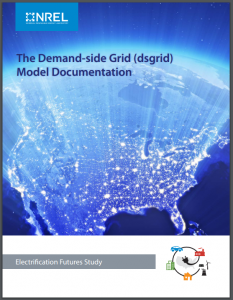Full Title: The Demand-Side Grid (dsgrid) Model Documentation
Author(s): Elaine Hale, Henry Horsey, Brandon Johnson, Matteo Muratori, Eric Wilson, Brennan Borlaug, Craig Christensen, Amanda Farthing, Dylan Hettinger, Andrew Parker, Joseph Robertson, Michael Rossol, Gord Stephen, Eric Wood, and Baskar Vairamohan
Publisher(s): National Renewable Energy Laboratory
Publication Date: August 1, 2018
Full Text: Download Resource
Description (excerpt):
Electrical load is the backdrop for all power systems analysis. As a coequal partner in the supply-demand balance that must be maintained on electrical grids at all times and for all timescales, load is a major source of variability and uncertainty in grid operations. Despite this, utility load forecasting is typically done in a top-down manner that lacks the granularity in time, geography, end use, and technology that is needed to explore the potential impact of technological shifts; and many studies of future grid systems employ relatively simple scaling of historical loads, placing more emphasis on supply-side resources such as generation and transmission that are fewer in number and are better understood in terms of cost and performance. The primary purpose of the demand-side grid model (dsgrid) is to fill these gaps by creating comprehensive load data sets at a sufficient temporal, geographic, sectoral, and end-use resolution to enable detailed analyses of current patterns and future projections of end-use load. Furthermore, the dsgrid platform uses a bottom-up methodology that allows highly resolved analysis of ‘what-if’ scenarios. dsgrid leverages detailed sectoral energy models to provide hourly time series of load by subsector, end use, and county covering a full year. Although dsgrid currently emphasizes electricity load data, its component sector models for residential buildings, commercial buildings, and industry provide information on other fuel use, including natural gas. The data sets can thus be leveraged to support analysis of numerous demand-side technology-driven changes, such as energy efficiency, electrification, and operational flexibility (i.e., demand response). The electricity use data are time-synchronized with solar and wind data sets so as to be suitable for use in power systems analysis. This report documents dsgrid and its initial data set, which covers electricity demand in the contiguous United States for the historical year of 2012. We start with a historical year to enable model calibration and validation, as well as the development of a mathematical description of our model residuals that can be applied to future-year ‘what-if’ scenarios to remove known errors between our bottom-up modeling and historical load shapes. This work is part of the Electrification Futures Study (EFS), for which the dsgrid team will be developing future load snapshots that describe projected year 2050 under baseline and a range of electrification assumptions.
